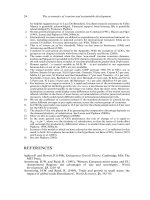THE ECONOMICS OF MONEY,BANKING, AND FINANCIAL MARKETS 345
Bạn đang xem bản rút gọn của tài liệu. Xem và tải ngay bản đầy đủ của tài liệu tại đây (27.37 KB, 1 trang )
PA R T I V
The Management of Financial Institutions
Chapter 13 Banking and the Management of Financial Institutions
Chapter 14 Risk Management with Financial Derivatives
CRISI S AN D RESP O NSE : CA NA DI AN BA NKS
ARE T HE WORL D S BE ST
During the subprime financial crisis the value of mortgage-backed securities held
by financial institutions plummeted and governments in the United States and
Europe worked on full-scale banking bailouts and rescue packages in the trillions
of dollars. Canada, however, did not have to bail out any banks, although
Canadian banks also had their problems. Their shares fell by almost 50% and some
of them experienced huge losses; for example, the CIBC suffered writedowns in
excess of $6 billion in 2008 because of significant exposure to the U.S. capital and
real estate markets.
One reason Canadian banks have done much better than their U.S. and
European counterparts is because Canada s banking regulator, the Office of the
Superintendent of Financial Institutions (OSFI), has been more conservative than
banking regulators in other countries. As a result, Canadian banks have lower
leverage and more conservative lending and acquisition practices. In fact, in the
aftermath of the subprime recession, Canada s banking system has been viewed
as the soundest in the world, with many countries considering Canadian-style
reforms of their financial markets.
Managing banks is not an easy task, and the subprime crisis highlights that it
has become even more difficult because of increased complexity in the financial
services marketplace. In Chapter 13 we look at the business and process of banking and in Chapter 14 we study financial derivatives and how managers of financial institutions use derivatives to manage different types of risk.
313









